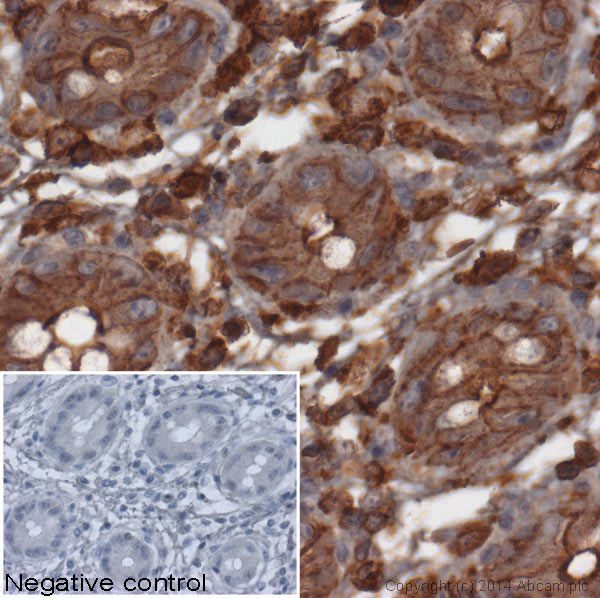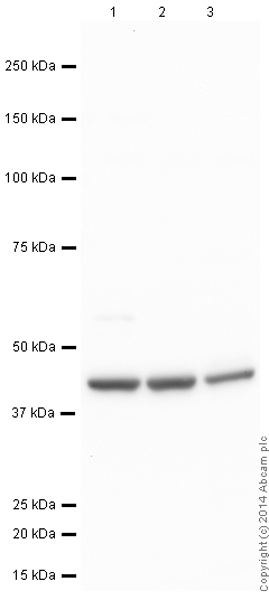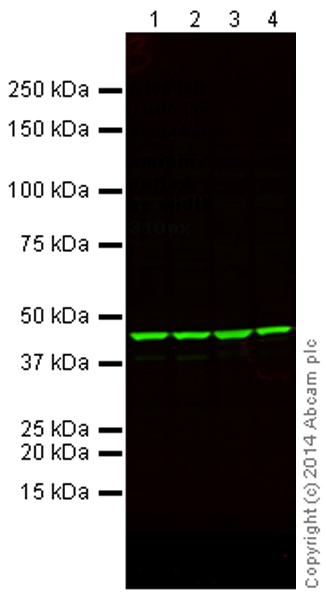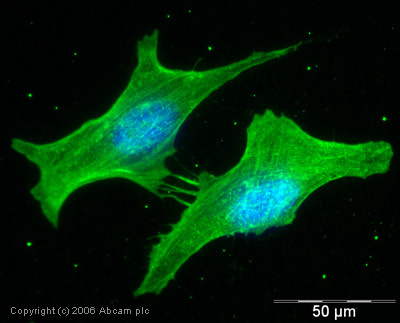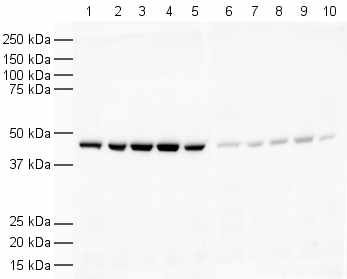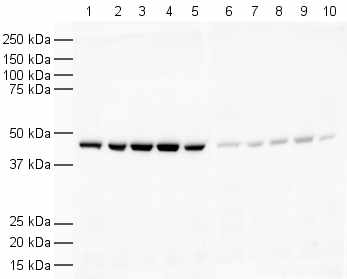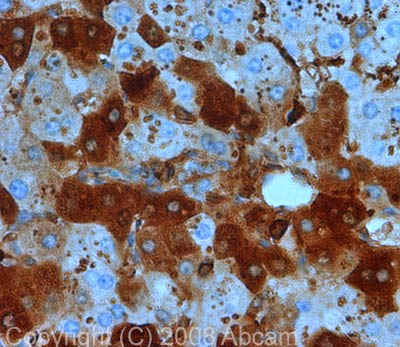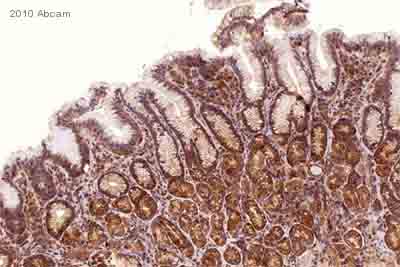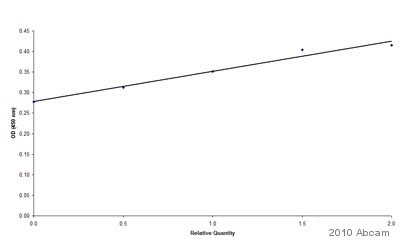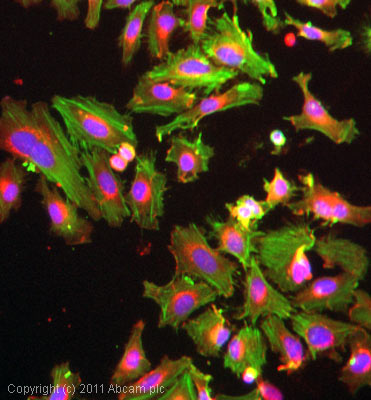Anti-beta Actin antibody
| Name | Anti-beta Actin antibody |
|---|---|
| Supplier | Abcam |
| Catalog | ab8227 |
| Prices | $404.00 |
| Sizes | 50 µg |
| Host | Rabbit |
| Clonality | Polyclonal |
| Isotype | IgG |
| Applications | IHC-F IP WB ICC/IF FC IHC-F IHC-P ICC/IF ICC/IF ELISA |
| Species Reactivities | Mouse, Rat, Sheep, Rabbit, Chicken, Guinea Pig, Bovine, Dog, Human, Pig, Xenopus, Drosophila, Fish, Monkey, Zebrafish, Monkey, Hamster |
| Antigen | Synthetic peptide derived from within residues 1 - 100 of Human beta Actin |
| Description | Rabbit Polyclonal |
| Gene | ACTB |
| Conjugate | Unconjugated |
| Supplier Page | Shop |
Product images
Product References
Transcriptional responses of neonatal mouse lung to hyperoxia by Nrf2 status. - Transcriptional responses of neonatal mouse lung to hyperoxia by Nrf2 status.
McGrath-Morrow SA, Lauer T, Collaco JM, Lopez A, Malhotra D, Alekseyev YO, Neptune E, Wise R, Biswal S. Cytokine. 2014 Jan;65(1):4-9.
Expression of receptors for BMP15 is differentially regulated in dominant and - Expression of receptors for BMP15 is differentially regulated in dominant and
Gasperin BG, Ferreira R, Rovani MT, Bordignon V, Duggavathi R, Buratini J, Oliveira JF, Goncalves PB. Anim Reprod Sci. 2014 Jan 30;144(3-4):72-8. doi:
Lipopolysaccharide activates Toll-like receptor 4 (TLR4)-mediated NF-kappaB - Lipopolysaccharide activates Toll-like receptor 4 (TLR4)-mediated NF-kappaB
Guijarro-Munoz I, Compte M, Alvarez-Cienfuegos A, Alvarez-Vallina L, Sanz L. J Biol Chem. 2014 Jan 24;289(4):2457-68.
Impact of age-associated increase in 2'-O-methylation of miRNAs on aging and - Impact of age-associated increase in 2'-O-methylation of miRNAs on aging and
Abe M, Naqvi A, Hendriks GJ, Feltzin V, Zhu Y, Grigoriev A, Bonini NM. Genes Dev. 2014 Jan 1;28(1):44-57.
Regulation of axon growth by the JIP1-AKT axis. - Regulation of axon growth by the JIP1-AKT axis.
Dajas-Bailador F, Bantounas I, Jones EV, Whitmarsh AJ. J Cell Sci. 2014 Jan 1;127(Pt 1):230-9.
Amino acids activate mammalian target of rapamycin (mTOR) complex 1 without - Amino acids activate mammalian target of rapamycin (mTOR) complex 1 without
Oshiro N, Rapley J, Avruch J. J Biol Chem. 2014 Jan 31;289(5):2658-74.
Subcellular expression and neuroprotective effects of SK channels in human - Subcellular expression and neuroprotective effects of SK channels in human
Dolga AM, de Andrade A, Meissner L, Knaus HG, Hollerhage M, Christophersen P, Zischka H, Plesnila N, Hoglinger GU, Culmsee C. Cell Death Dis. 2014 Jan 16;5:e999.
Loss of the neuroprotective factor Sphingosine 1-phosphate early in Alzheimer's - Loss of the neuroprotective factor Sphingosine 1-phosphate early in Alzheimer's
Couttas TA, Kain N, Daniels B, Lim XY, Shepherd C, Kril J, Pickford R, Li H, Garner B, Don AS. Acta Neuropathol Commun. 2014 Jan 23;2:9.
Iron transport through ferroportin is induced by intracellular ascorbate and - Iron transport through ferroportin is induced by intracellular ascorbate and
Scheers N, Sandberg AS. Nutrients. 2014 Jan 3;6(1):249-60.
Complement expression in the retina is not influenced by short-term pressure - Complement expression in the retina is not influenced by short-term pressure
Astafurov K, Dong CQ, Panagis L, Kamthan G, Ren L, Rozenboym A, Perera TD, Coplan JD, Danias J. Mol Vis. 2014 Jan 31;20:140-52. eCollection 2014.
![IHC image of beta actin staining in a section of formalin-fixed paraffin-embedded [human normal colon]*. The section was pre-treated using pressure cooker heat mediated antigen retrieval with sodium citrate buffer (pH6) for 30mins. The section was then incubated with ab8227, 1/1000 dilution, for 15 mins at room temperature. A goat anti-rabbit biotinylated secondary antibody (ab6720, 1/1000 dilution) was used to detect the primary, and visualized using an HRP conjugated ABC system. Streptavidin HRP was used, ab7403 at a 1/10000 dilution. DAB was used as the chromogen (ab103723), diluted 1/100 and incubated for 10min at room temperature. The section was then counterstained with haematoxylin and mounted with DPX. The inset negative control image is taken from an identical assay without primary antibody.For other IHC staining systems (automated and non-automated) customers should optimize variable parameters such as antigen retrieval conditions, primary antibody concentration and antibody](http://www.bioprodhub.com/system/product_images/ab_products/2/sub_1/13576_ab8227-242969-ab8227101ugmlab6720-2-1ugml-hu-colon-x20.jpg)
